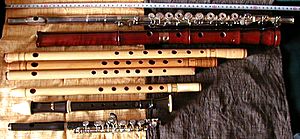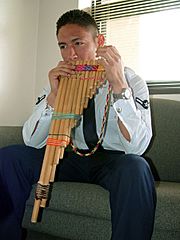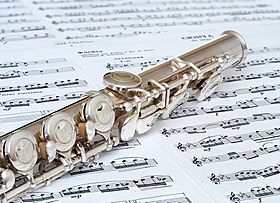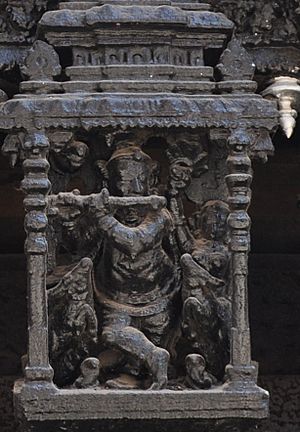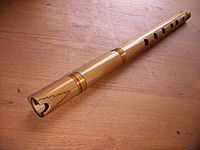Flute facts for kids
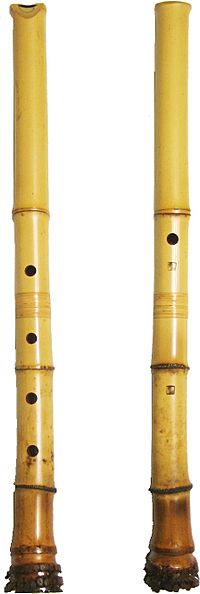
The Flute is a musical instrument. A person who plays a flute is called a flautist.
There are many kinds of flutes. The most common concert flute is on C tuning. In addition, there are other flutes like piccolos, alto flutes, and bass flutes.
Contents
History
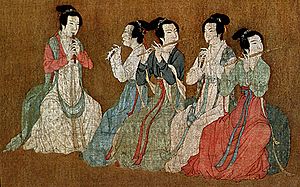

Flutes have changed over time. Pan flutes were made for many centuries. Later, the "Renaissance flute" came into use. In Baroque music 'flute' means recorder, so flute was called traverso in order not to confuse them. A Bavarian flute maker named Boehm reformed past flute largely to enlarge the volume and improve the way of using the chromatic scale. Later improvements created the modern flute.
There is a large repertoire of music for the flute. Baroque composers used them in their orchestras, usually in pairs, and composed concertos, chamber music and solo music for them. This has continued to the present day. Orchestras have at least 2 flutes each, sometimes three or four. Sometimes there is 1 piccolo which plays an octave higher, or an alto flute which plays a fifth lower than the flute.
The flute sounds very bright and cheerful playing high notes. Please listen, for example, to the Badinerie from Bach's Orchestral Suite no 2. It can also sound very thoughtful or sad when playing in its lowest register. A good example is the opening of Debussy's Prélude à l'après midi d'un faune.
Playing
Flutes can give microtonal music by using special fingering. Flute has many variation of the sound.
Flute is one of the woodwind instruments, but flute is made of metal. It was made of wood a long time ago. It doesn't need lip vibration like brass instruments. Flute players hold it flat, and make a sound by blowing their breath over the edge of the hole of flute's head. It sounds thanks to the vibration of air. Although, flutes need the second most amount of air for an instrument, next to the tuba. Flautists can change the pitch by pushing buttons or changing the direction of the breath. These buttons are called keys. The breath also can change the tone or the volume. The sound of flute is high, so composers often express it as a bird. And a flute matches with many instrument like violin and piano. Flute is a key instrument in many ensembles.
Material
There are many kinds of flute, so the material also varies. Most flutes are made of silver. Gold, platinum, and wood are also used. The price of flute depends on the material, but there are many different playing situations, so not only expensive flutes are useful.
Kinds of Flutes
In its most basic form, a flute is an open tube which is blown into. After focused study and training, players use controlled air-direction to create an airstream in which the air is aimed downward into the tone hole of the flute's headjoint. There are several broad classes of flutes.
With most flutes, the musician blows directly across the edge of the mouthpiece, with 1/4 of their bottom lip covering the embouchure hole. However, some flutes, such as the whistle, gemshorn, flageolet, recorder, tin whistle, tonette, fujara, and ocarina have a duct that directs the air onto the edge (an arrangement that is termed a "fipple"). These are known as fipple flutes. The fipple gives the instrument a distinct timbre which is different from non-fipple flutes and makes the instrument easier to play, but takes a degree of control away from the musician.
Another division is between side-blown (or transverse) flutes, such as the Western concert flute, piccolo, fife, dizi and bansuri; and end-blown flutes, such as the ney, xiao, kaval, danso, shakuhachi, Anasazi flute and quena.
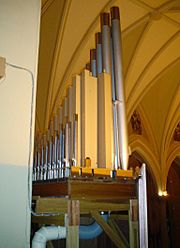
The player of a side-blown flute uses a hole on the side of the tube to produce a tone, instead of blowing on an end of the tube. End-blown flutes should not be confused with fipple flutes such as the recorder, which are also played vertically but have an internal duct to direct the air flow across the edge of the tone hole.
Flutes can be played with several different air sources. Conventional flutes are blown with the mouth, although some cultures use nose flutes. The flue pipes of organs, which are acoustically similar to duct flutes, are blown by bellows or fans.
Western transverse flutes
Wooden one-keyed transverse flute
Usually in D, wooden transverse flutes were played in European classical music mainly in the period from the early 18th century to the early 19th century. As such the instrument is often indicated as baroque flute. Gradually marginalized by the Western concert flute in the 19th century, baroque flutes were again played from the late 20th century as part of the historically informed performance practice.
Western concert flute
The Western concert flute, a descendant of the medieval German flute, is a transverse treble flute that is closed at the top. An embouchure hole is positioned near the top across and into which the flutist blows. The flute has circular tone holes larger than the finger holes of its baroque predecessors. The size and placement of tone holes, key mechanism, and fingering system used to produce the notes in the flute's range were evolved from 1832 to 1847 by Theobald Boehm and greatly improved the instrument's dynamic range and intonation over its predecessors. With some refinements (and the rare exception of the Kingma system and other custom adapted fingering systems), Western concert flutes typically conform to Boehm's design, known as the Boehm system. Beginner's flutes are made of nickel, silver, or brass that is silver-plated, while professionals use solid silver, gold, and sometimes platinum flutes. There are also modern wooden-bodied flutes usually with silver or gold keywork. The wood is usually African Blackwood.
The standard concert flute is pitched in C and has a range of three octaves starting from middle C or one half step lower when a B foot is attached. This means the concert flute is one of the highest common orchestra and concert band instruments.
Western concert flute variants
The piccolo plays an octave higher than the regular treble flute. Lower members of the flute family include the G alto and C bass flutes that are used occasionally, and are pitched a perfect fourth and an octave below the concert flute, respectively. The contrabass, double contrabass, and hyperbass are other rare forms of the flute pitched two, three, and four octaves below middle C respectively.
Other sizes of flutes and piccolos are used from time to time. A rarer instrument of the modern pitching system is the treble G flute. Instruments made according to an older pitch standard, used principally in wind-band music, include D♭ piccolo, soprano flute (the primary instrument, equivalent to today's concert C flute), F alto flute, and B♭ bass flute.
Indian flutes
The bamboo flute is an important instrument in Indian classical music, and developed independently of the Western flute. The Hindu God Lord Krishna is traditionally considered a master of the bamboo flute. The Indian flutes are very simple compared to the Western counterparts; they are made of bamboo and are keyless.
Two main varieties of Indian flutes are currently used. The first, the Bansuri (बांसुरी), has six finger holes and one embouchure hole, and is used predominantly in the Hindustani music of Northern India. The second, the Venu or Pullanguzhal, has eight finger holes, and is played predominantly in the Carnatic music of Southern India. Presently, the eight-holed flute with cross-fingering technique is common among many Carnatic flutists. Prior to this, the South Indian flute had only seven finger holes, with the fingering standard developed by Sharaba Shastri, of the Palladam school, at the beginning of the 20th century.
The quality of the flute's sound depends somewhat on the specific bamboo used to make it, and it is generally agreed that the best bamboo grows in the Nagercoil area of South India.
Based on Bharata Natya Shastra Sarana Chatushtai, Avinash Balkrishna Patwardhan in 1998 developed a methodology to produce perfectly tuned flutes for the ten 'thatas' currently present in Indian Classical Music.
Chinese flutes
In China there are many varieties of dizi (笛子), or Chinese flute, with different sizes, structures (with or without a resonance membrane) and number of holes (from 6 to 11) and intonations (different keys). Most are made of bamboo, but can come in wood, jade, bone, and iron. One peculiar feature of the Chinese flute is the use of a resonance membrane mounted on one of the holes that vibrates with the air column inside the tube. This membrane is called a di mo, which is usually a thin tissue paper. It gives the flute a bright sound.
Commonly seen flutes in the modern Chinese orchestra are the bangdi (梆笛), qudi (曲笛), xindi (新笛), and dadi (大笛). The bamboo flute played vertically is called the xiao (簫), which is a different category of wind instrument in China.
Japanese flutes
The Japanese flute, called the fue, 笛 (hiragana: ふえ), encompasses a large number of musical flutes from Japan, include the end-blown shakuhachi and hotchiku, as well as the transverse gakubue, komabue, ryūteki, nōkan, shinobue, kagurabue and minteki.
Sodina and suling
The sodina is an end-blown flute found throughout the island state of Madagascar, located in the Indian Ocean off southeastern Africa. One of the oldest instruments on the island, it bears close resemblance to end-blown flutes found in Southeast Asia and particularly Indonesia, where it is known as the suling, suggesting the predecessor to the sodina was carried to Madagascar in outrigger canoes by the island's original settlers emigrating from Borneo. An image of the most celebrated contemporary sodina flutist, Rakoto Frah (d. 2001), was featured on the local currency.
Sring
The sring (also called blul) is a relatively small, end-blown flute with a nasal tone quality found in the Caucasus region of Eastern Armenia. It is made of wood or cane, usually with seven finger holes and one thumb hole, producing a diatonic scale. One Armenian musicologist believes the sring to be the most characteristic of national Armenian instruments.
Gallery
There are flutes in many cultures. The flute has been described as "a musical weed which springs up everywhere".
Famous Flutists
The band Jethro Tull was founded by a flute player (Ian Anderson) and it can be heard in many songs. One of which is the hit Locomotive Breath.
Related pages
Images for kids
See also
 In Spanish: Flauta para niños
In Spanish: Flauta para niños


